The Microsoft Surface Studio Review
by Brett Howse on January 20, 2017 8:00 AM EST- Posted in
- Desktop
- Microsoft
- Surface
- Surface Studio
System Performance
As is typical with an all-in-one PC, the Surface Studio uses mobile parts to ensure things don’t get too toasty. The base model ships with a Core i5-6440HQ, which is a quad-core processor running at 2.6-3.5 GHz. There is 6 MB of cache and no hyperthreading, and it has a 45-Watt TDP. The CPU is likely fine for most tasks, but the base Surface Studio comes with just 8 GB of DDR4 memory, which would hardly be called adequate for an almost $3000 computer. Graphics to run the 13.5 million pixel display come courtesy of the NVIDIA GeForce GTX 965M, launched at CES in 2015.
The jump up to the mid-level model offers a lot more computer, but comes at a cost of an additional $500. The CPU is upgraded to the Core i7-6820HQ, which is a quad-core with hyperthreading, and a 2.7-3.6 GHz frequency, along with 8 MB of cache. The big upgrade is the RAM, which doubles to a more respectable 16 GB, and while the GPU is the same, and the hard drive capacity is the same, the mid-level model doubles the SSD cache from a 64 GB SATA SSD to a 128 GB PCIe SSD. While the CPU is going to offer more performance, especially in heavily-threaded workloads, the increased RAM and SSD cache are likely to do more for the overall performance than anything, and the mid-level is really where the Surface Studio should have started.
Our review unit is the top level model, with the same Core i7-6820HQ CPU as the mid-level model, but with double the RAM again, which means 32 GB of DDR4. The hybrid hard drive capacity is also doubled, to 2 TB, with the same 128 GB of PCIe SSD cache. The biggest upgrade on the top model is the graphics, which jumps from the GeForce GTX 965M all the way to the GeForce GTX 980M. This was the top mobile graphics card available until earlier this year when the GeForce GTX 10 series launched, and it offers quite a bit more performance. The GTX 965M was a solid performer for low-end gaming, but the GTX 980M offers more of everything, with double the video memory to 4 GB, more memory bandwidth, more CUDA cores, and far more performance.
Much has been made of the fact that the Surface Studio shipped with “old technology” in a Skylake CPU, when Kaby Lake CPUs were available, and especially the Maxwell based graphics, when Pascal was launched. The CPU argument was never true though, with quad-core Kaby Lake only available since the beginning of 2017, and Kaby Lake offers no IPC increases over Skylake, although they can run at a higher frequency for the same power consumption. The GPU argument is sound though, and the Pascal based GPUs would offer greater performance for less power consumption, and therefore less heat generated. The new GPUs are not pin-compatible though, meaning Microsoft would have had to redesign the board completely, as well as possibly addressed the different TDPs of the mobile chips, but this would have been engineering time well spent.
| NVIDIA Mobile Maxwell GPUs | |||||
| GeForce GTX 965M | GeForce GTX 980M | ||||
| CUDA Cores | 1024 | 1536 | |||
| Core Clock | 944 + Boost | 1038 + Boost | |||
| Memory | 2 GB GDDR5 128-bit | 4 GB GDDR5 256-bit | |||
| Memory Clock | 2500 MHz | 2500 MHz | |||
| Memory Bandwidth | 80 GB/s | 160 GB/s | |||
Ultimately, it would have been nice to see a GTX 1070 and GTX 1060 options, or even a GTX 1050 to replace the GTX 965M, although that GPU just launched for laptops at CES 2017. The performance increases alone would be significant, but there are also advantages such as full hardware decode for HEVC on the Pascal chips which would have been a nice feature. Clearly the timing did not work out, and Microsoft said they had to choose the components a year before launch. They likely didn’t want to risk choosing Pascal and then having supply issues, but at the end of the day they made a conservative decision.
So let’s see how the Surface Studio does perform, with the Skylake and Maxwell combination that is available. The Surface Studio was run through our standard suite of tests, and for comparisons it is put up against some of the more recent laptops we’ve tested.
PCMark
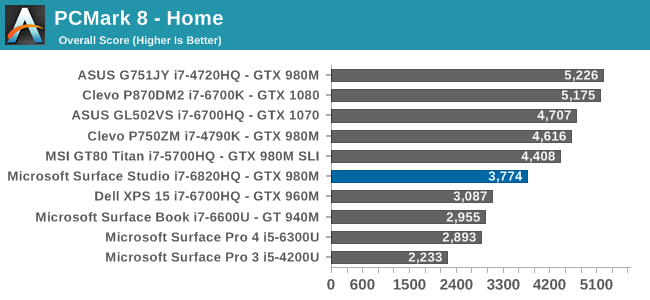

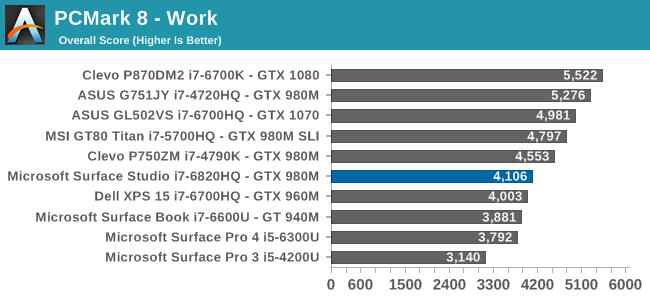
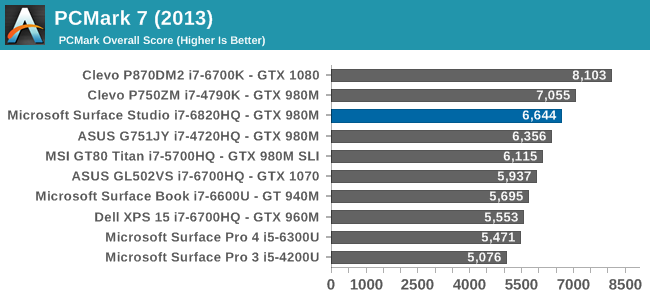
PCMark is a comprehensive set of tests, which uses real-world applications to test system responsiveness and performance. All aspects of the system are tested, including the storage, and even display resolution can have an affect. Here the Surface Studio is decidedly average, with decent scores in some tests, but less than amazing results in others. The hybrid storage and high display resolution likely didn’t help out the Surface Studio here.
Cinebench
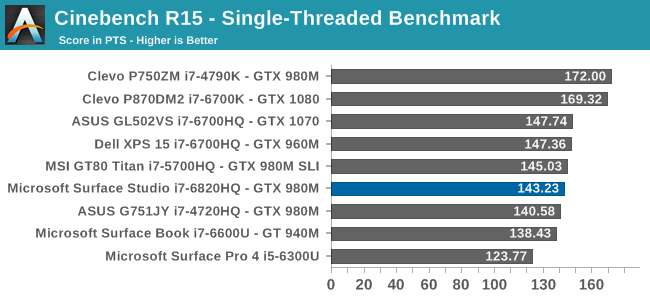
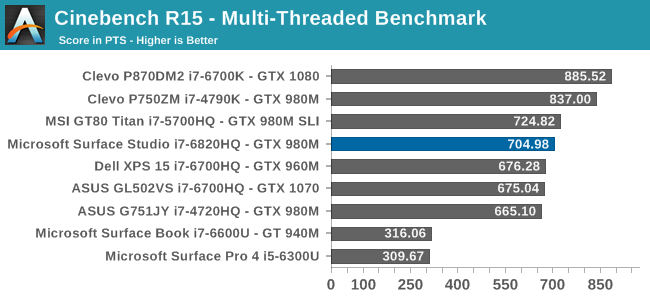
Cinebench is a purely CPU test, and despite the Surface Studio having a Core i7-6820HQ when most quad-core laptops are the i7-6700HQ, it still fell slightly below them on this test.
X264
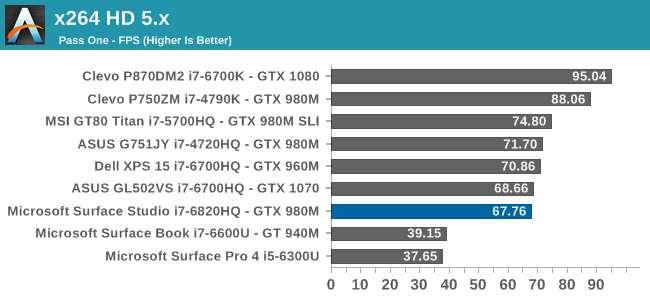
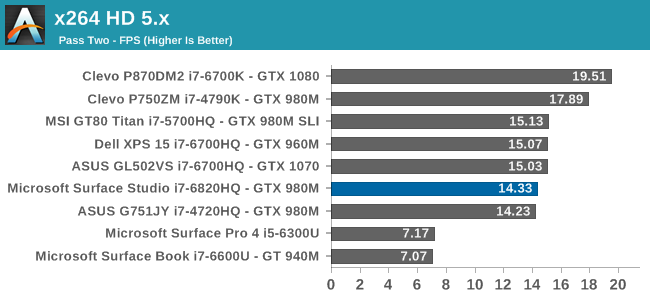
Much like Cinebench, this is a pure CPU test, but unlike Cinebench which renders an image, x264 encodes a video file. As with Cinebench, the Surface Studio falls a bit under the performance of the i7-6700HQ found in most notebooks.
Web Tests
Browsing the web is likely what most computers do, most of the time, but unlike the previous tests, web tests are always evolving over time as the underlying browsers are updated. For our tests, we use the latest version of Microsoft Edge.
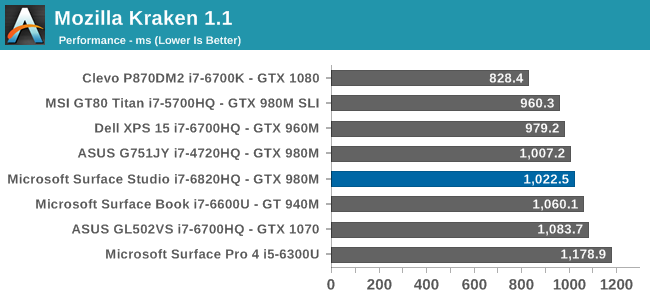
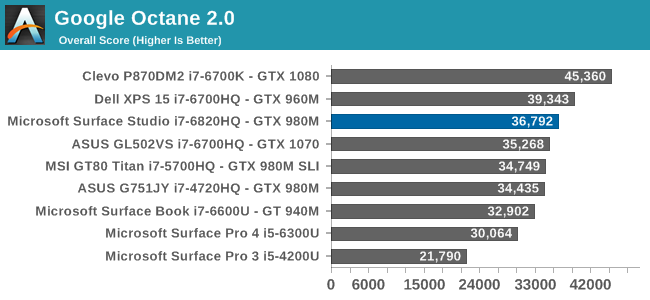

As with the other tests, the Surface Studio falls just a hair under the performance of typical quad-core laptops. With a sample size of one, it’s difficult to point the finger at why this is – is it cooling or is it something else – but I would have expected it to be just slightly ahead of the i7-6700HQ machines.










197 Comments
View All Comments
Brett Howse - Friday, January 20, 2017 - link
It also has a much smaller, lower resolution display, without touch support.BillBear - Friday, January 20, 2017 - link
That doesn't become worthless when you need to upgrade the computer's hardware.If you're going to make something this expensive, yet disposable due to a lack of hardware upgradability, it needs to at least be on par with existing professional drawing tools. Wacom's pen is much more advanced, it's color management is much more advanced, and the Express Key Remote is much more advanced than the Surface Dial.
Also, I'm not sure where you get the notion that Wacom's products can not support multitouch.
jlabelle2 - Sunday, January 22, 2017 - link
How does this "double pressure" sensitivity translates in real world?Let's imagine that you have 1024 level of pressure, and that the max displacement of the screen would be 1mm when pressing fully, it means that 1 increment of level of pressure corresponds to less than 0,001mm or 1um. Does home people really believe it makes a difference and people can be as precise as that? Lol.
id4andrei - Friday, January 20, 2017 - link
Tipoo, all Surfii are hybrids. I think MS will never allow you to plug into a Surface to use just the screen. It's about driving(forcefully) a way of computing consisting with MS vision. It's PC plus as opposed to post PC.theuglyman0war - Saturday, January 28, 2017 - link
There is a 27 inch wacom digitizer? No one tells me anything. :(I been waiting for a pressure sensitive pen enabled tablet/aio at 27 inches or higher forever. The nearly 5k fidelity is nearly to much to resist. Breathtaking? Id take one of these first attempts at this form factor over a front row seat for the next Hailey's comet at the grand canyon with the playmate of the year giving me a lap dance. Even knowing that improved versions are most likely going to be released that address silly issues because I have been waiting forever for large. And for an old school traditional background artist who had the idea that going small, precious and timid was a sin where going large and drawing sweeping gesture friendly strokes on a large canvas using more than anemic carpal inducing wrist motion is an ingrained prejudice I have been suffering with no relief. I would have to believe then that I am the target market and anyone that doesn't find rabid excitement in the prospect of next years release simply because this AIO now exists... Simply is not the intended creative type in mind who has been waiting so long they r stupid enough to pay the ridiculous price and r grateful for the opportunity.
Even the dial that slides down the screen.! Just the idea that future iterations might have the Jog Shuttle sexiness of an old GVG Grass Valley Group editing dial for dialing in sublime levels of interactive seeking has me literally frothing rabid with anticipation! ( Particularly if they allow future implementations to be as open and supported as their Dev friendly Kinect example! )
I find more exciting at the prospect of future versions simply because the device form factor with it's initial faults is finally here! ( please.. must go larger )
The last thing I want to hear is naysaying ( God forbid they decide to close shop on this line of product from as much negativity )
Silly I know... But from my point of view the machine is as precariously fragile as a newborn infant from the point of view of a newborn father who thought he was infertile and only wants to see that potential grow up and be...
Realized!
BillBear - Friday, January 20, 2017 - link
The Surface Dial is not so much innovative as it is a direct copy of Adobe's "place a plastic object on the screen to give commands while drawing" Ink and Slide idea from several years ago.https://www.youtube.com/watch?v=ifmRgQX82O4
BillBear - Friday, January 20, 2017 - link
Youtube fail!https://www.youtube.com/watch?v=j4wzIumB5PU
nathanddrews - Friday, January 20, 2017 - link
Microsoft's Surface predates Adobe's Ink and Slide by several years. Detection and interaction with real world objects existed with Surface 1.0.https://youtu.be/6VfpVYYQzHs
BrokenCrayons - Friday, January 20, 2017 - link
I beleive the point was that the DIAL, just released with the Surface Studio was predated by the Ink and Slide thingy from Adobe and doesn't appear to be a unique or new idea.BillBear - Friday, January 20, 2017 - link
Likewise, in the professional drawing space, Wacom's Cintiq has long come with the Express Key Remote, which is another take on the "place a plastic object on the screen to give commands while drawing" concept.I was at a loss to see how so many reviewers claimed Microsoft was being "innovative" here.